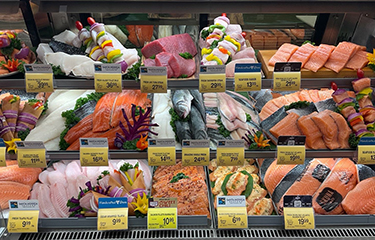Fresh and frozen seafood sales continued their decline in U.S. supermarkets in July due to inflation and increased restaurant visits, but shelf-stable seafood sales rose as cost-conscious consumers look for ways to save money.
Frozen seafood sales dropped 7.4 percent during the month to USD 651 million (EUR 640 million). Fresh seafood fell even more, falling 9.9 percent to USD 638 million (EUR 627 million), according to new data from IRI and 210 Analytics.
“Frozen often does well in times of recessionary pressure. In the mind of the consumer, frozen tends to have a price advantage. In reality, this isn’t always the case, but it’s a long-rooted perception,” 210 Analytics Principal Anne-Marie Roerink told SeafoodSource.
Plus, frozen seafood can be used a little at a time and there’s no waste. “This all weighs more heavily when there is a lot of pressure on the food dollar,” Roerink said.
Frozen seafood had the highest increase in price due to inflation in July, rising 11.8 percent, while prices on fresh seafood rose 10.2 percent.
“The price inflation in fresh seafood was predominantly driven by finfish, up 18.2 percent in the average price per unit compared with July 2021,” Roerink said.
Conversely, shellfish prices rose only 1.4 percent in July.
The average cost per unit and inflation has been much lower for shelf-stable seafood, according to Roerink, rising 9.1 percent to USD 2.06 (EUR 2.02) per unit on average.
During this time of consumer concern about inflation, shelf-stable seafood (both canned and pouches) was the only seafood category that gained in sales value, rising 6.7 percent to USD 261 million (EUR 256 million).
“Ambient seafood often does well during times of inflation and uncertainty. Today’s marketplace is no exception,” Roerink said, noting that sales rose 11 percent in the category versus July 2019. In addition, July marked the sixth consecutive month of year-on-year dollar growth for ambient seafood, she said.
The shift in buying habits were highlighted by retail giant Walmar’s latest quarterly results. Walmart’s quarterly sales rose 8 percent, while profits tightened, which the retailer partially attributed to more middle and higher-income consumers seeking value purchases with smaller margins.
Walmart shoppers are opting for smaller packages of food and buying items like canned tuna and beans instead of deli meats and beef, Walmart chief Financial Officer John David Rainey told CNBC.
To further capitalize on consumers’ increased propensity towards canned and pouched seafood, grocers should offer recipes utilizing the seafood as an ingredient, Roerink said.
“People love a new twist to an old favorite. Why not have some fun with a fun take on the classic tuna casserole? Or, with today’s popularity of wraps and flatbreads, create a twist on a tuna salad sandwich,” Roerink said.
While The NPD Group found that U.S. consumers cut back on their restaurant visits in the second quarter of 2022 due to inflation, IRI’s data shows that more consumers are utilizing restaurants.
Despite some consumers saying they planned to eat out less often to save money, 80 percent of consumers have ordered from or eaten at a restaurant in the past few weeks, according to Roerink.
In addition, the share of home-prepared meals dropped to its lowest point in years in July, at an estimated 78.2 percent of all meals, according to IRI. The average share of home-prepared meals is higher among low-income shoppers (78.9 percent) versus high-income shoppers (76.1 percent).
“The early pandemic months saw lower consumer mobility and more time in the kitchen. As life’s hectic-ness has resumed, the eternal battle between time, convenience, and money has intensified in the past year,” Roerink said. “This has resulted in very complex consumption and shopping patterns. We see the same household take to scratch cooking one day and value-added or deli solutions the next. We see ultra-premium and pure value items in the same basket. We see consumers switch seamlessly between quick frozen meal solutions or fresh meal kits and spending hours on cooking meat on the smoker.”
Seafood suppliers can cater to consumers looking for a value, healthfulness, and convenient meal solutions “by emphasizing solutions for all,” Roerink said. "We already firmly play in healthfulness; consumers very much associate seafood with being generally healthful. How can we offer cost-effective solutions and convenient ones?”
Meanwhile, online shopping rose in July, accounting for 19 percent of all shopping trips, according to IRI.
“Those who have integrated online shopping into their lineup are enjoying the convenience but grocery e-commerce has also emerged as a money-saving measure to help control the total basket spend,” Roerink said.
Photo courtesy of 210 Analytics







